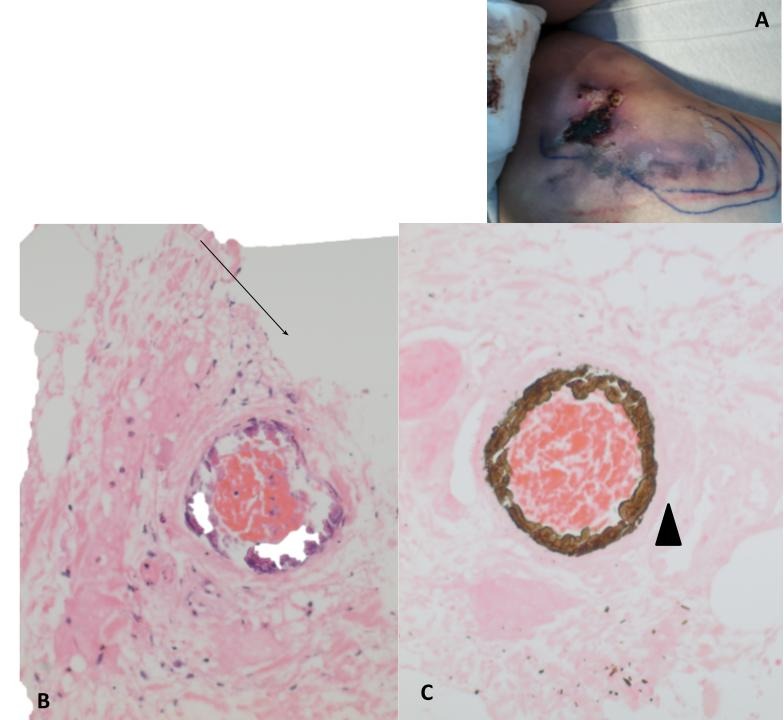Back


Poster Session B - Monday Morning
Category: Liver
B0580 - Calciphylaxis Due to Alcoholic Liver Disease
Monday, October 24, 2022
10:00 AM – 12:00 PM ET
Location: Crown Ballroom

Has Audio

Kanhai Farrakhan, MD
Warren Alpert Medical School of Brown University
Providence, Rhode Island
Presenting Author(s)
Kanhai Farrakhan, MD1, Daniel Marino, MD, MBA1, Janet Guo, BS2, Ronan Farrell, MD3
1Warren Alpert Medical School of Brown University, Providence, RI; 2Brown University, Providence, RI; 3Brown Medicine, Providence, RI
Introduction: Advanced liver disease often has multiorgan involvement, including dermatological findings. These range from spider angiomas to palmar erythema. Here we present a case of calciphylaxis as a manifestation of decompensated alcoholic liver disease.
Case Description/Methods: A 38 year-old female with decompensated alcoholic cirrhosis (portal vein thrombosis, ascites, hepatic encephalopathy, and hepatic hydrothorax) reported to the emergency room complaining of new right thigh wounds. Her vital signs were unremarkable and her exam demonstrated ascites and bilateral lower extremity edema with right medial thigh erythema, induration, and superficial ulceration (Figure 1). Labs showed sodium 125 mEq/L, Creatinine 0.95 mg/dL, WBC 16.2 x109, and total bilirubin 1.6 mg/dL. CT of her thigh demonstrated bilateral, symmetric subcutaneous induration consistent with anasarca and possible superimposed cellulitis. She was admitted and treated with IV antibiotics. As the lesions became duskier and more painful dermatology was consulted who initially were concerned for a vasculopathic process versus calciphylaxis. The patient was placed on empiric treatment for calciphylaxis with sodium thiosulfate. Skin biopsies were performed and showed non-uremic calciphylaxis (Figure 2). The patient then developed an AKI thought to be from hepato-renal syndrome and was trialed on albumin, midodrine, and octreotide with no improvement in renal function. She then developed acidosis, eventually requiring a bicarb drip, and her wounds continued to progress (Figure 1). When she started becoming repeatedly hypotensive her family transitioned her to comfort care and she was discharged to hospice.
Discussion: Calciphylaxis is a rare disease that was first described in 1961 by Selye et al and is largely thought to be related to uremia. Here we describe a case of calciphylaxis in a patient with alcoholic liver disease and initial normal renal function. Our review of the literature found fewer than 11 case reports of calciphylaxis associated with liver disease. The mechanism in these cases appears to be poorly understood though is believed to be connected to protein C and protein S deficiency. As in those with advanced renal disease, calciphylaxis has a poor prognosis with high mortality often reported as greater than 50% even despite treatment. Thus it is important that clinicians recognize its association with alcoholic liver disease to aid in diagnosis and ensure prompt initiation of treatment.

Disclosures:
Kanhai Farrakhan, MD1, Daniel Marino, MD, MBA1, Janet Guo, BS2, Ronan Farrell, MD3. B0580 - Calciphylaxis Due to Alcoholic Liver Disease, ACG 2022 Annual Scientific Meeting Abstracts. Charlotte, NC: American College of Gastroenterology.
1Warren Alpert Medical School of Brown University, Providence, RI; 2Brown University, Providence, RI; 3Brown Medicine, Providence, RI
Introduction: Advanced liver disease often has multiorgan involvement, including dermatological findings. These range from spider angiomas to palmar erythema. Here we present a case of calciphylaxis as a manifestation of decompensated alcoholic liver disease.
Case Description/Methods: A 38 year-old female with decompensated alcoholic cirrhosis (portal vein thrombosis, ascites, hepatic encephalopathy, and hepatic hydrothorax) reported to the emergency room complaining of new right thigh wounds. Her vital signs were unremarkable and her exam demonstrated ascites and bilateral lower extremity edema with right medial thigh erythema, induration, and superficial ulceration (Figure 1). Labs showed sodium 125 mEq/L, Creatinine 0.95 mg/dL, WBC 16.2 x109, and total bilirubin 1.6 mg/dL. CT of her thigh demonstrated bilateral, symmetric subcutaneous induration consistent with anasarca and possible superimposed cellulitis. She was admitted and treated with IV antibiotics. As the lesions became duskier and more painful dermatology was consulted who initially were concerned for a vasculopathic process versus calciphylaxis. The patient was placed on empiric treatment for calciphylaxis with sodium thiosulfate. Skin biopsies were performed and showed non-uremic calciphylaxis (Figure 2). The patient then developed an AKI thought to be from hepato-renal syndrome and was trialed on albumin, midodrine, and octreotide with no improvement in renal function. She then developed acidosis, eventually requiring a bicarb drip, and her wounds continued to progress (Figure 1). When she started becoming repeatedly hypotensive her family transitioned her to comfort care and she was discharged to hospice.
Discussion: Calciphylaxis is a rare disease that was first described in 1961 by Selye et al and is largely thought to be related to uremia. Here we describe a case of calciphylaxis in a patient with alcoholic liver disease and initial normal renal function. Our review of the literature found fewer than 11 case reports of calciphylaxis associated with liver disease. The mechanism in these cases appears to be poorly understood though is believed to be connected to protein C and protein S deficiency. As in those with advanced renal disease, calciphylaxis has a poor prognosis with high mortality often reported as greater than 50% even despite treatment. Thus it is important that clinicians recognize its association with alcoholic liver disease to aid in diagnosis and ensure prompt initiation of treatment.

Figure: A: Right medial thigh wound
B: High power of calcium deposits and thrombus (arrow) within the subcutaneous fat
C: corresponding von kossa stain (arrowhead)
B: High power of calcium deposits and thrombus (arrow) within the subcutaneous fat
C: corresponding von kossa stain (arrowhead)
Disclosures:
Kanhai Farrakhan indicated no relevant financial relationships.
Daniel Marino indicated no relevant financial relationships.
Janet Guo indicated no relevant financial relationships.
Ronan Farrell indicated no relevant financial relationships.
Kanhai Farrakhan, MD1, Daniel Marino, MD, MBA1, Janet Guo, BS2, Ronan Farrell, MD3. B0580 - Calciphylaxis Due to Alcoholic Liver Disease, ACG 2022 Annual Scientific Meeting Abstracts. Charlotte, NC: American College of Gastroenterology.

